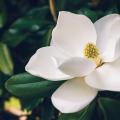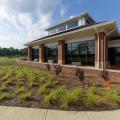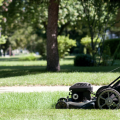Plants for Green Walls
 Green walls are places where plants are growing on the sides of buildings or other vertical structures.
Green walls are places where plants are growing on the sides of buildings or other vertical structures.
This may include exterior building walls, fences or retaining walls, or even the interiors of buildings. The benefits to planting a green wall are many, including:
- Visually enhances unappealing wall spaces.
- Cools the sides of a building from direct summer sunlight, reducing indoor cooling needs.
- Provides an extra layer of insulation for building sides.
- Reduces traffic and other urban noises from building interiors.
- Reduces the urban heat island affect in cities.
- Improves carbon sequestration and air quality in urban areas.
- Provides additional wildlife habitat in urban areas.
- Provides additional points for L.E.E.D. certified buildings (Leadership in Energy and Environmental Design Green Building Rating System™).
- Provides additional green space in a vertical format.
Vines, such as English ivy, creeping fig, or Virginia creeper, have been used to enhance building facades on brick structures for many centuries. These types of vines form adventitious roots or disks along the climbing stem that adhere to brick and wood. These roots can penetrate small spaces between brick mortar and cause damage to brick and wood. Successfully removing these vines from building sides can be a costly and labor intensive process.
Trellis or wire
There are many other methods of creating green walls other than the traditional use of vines, including some new technological advances. The simplest and least expensive method to create a green wall would be to construct a freestanding or attached trellis. A freestanding trellis is a frame of wood or metal that is anchored to the ground. Maintain a distance from the wall of at least 6 to 8 inches to allow for air circulation to reduce mold and moisture buildup on building sides.
Some freestanding structures around buildings (such as fences) require building permits or may need to meet other local ordinance codes. Vines that use non-attaching tendrils to climb, such as coral honeysuckle (Lonicera sempervirens), clematis (Clematis spp.), or yellow jasmine (Gelsemium sempervirens) will use the trellis for support. Plant species may be chosen according to the height of the wall being covered, with some species reaching over 70 feet in height. For more species of vines suitable for the Southeast, see the Designing with Vines factsheet. Wood lattice that is often available in hardware stores often has a short use life and requires regular maintenance.
An alternative inexpensive method to a trellis is using cables or coated wire. Similar to using string or wire for string beans, cables are anchored into the ground and are attached to roof eaves or wall anchors. Vines are planted in the ground and allowed to climb the wire, or may be established in planters in the base. Vines that are planted in the ground offer the least maintenance for watering and care as compared to other green wall systems. The wires are spaced according to the density of foliage that is desired. Wall anchor and wire kits are available from a variety of manufacturers.
Green Walls
Green walls utilize a metal framework that is detached from the building sides (similar to a freestanding trellis) and supports panel-type planting units that hold a lightweight soil. Metal frames that are attached to building sides will require a waterproof membrane between the growing media and the wall surface. The panels are modular units that fit into the metal framework, and are available in various patterns and grid sizes. The soil media is a sponge-like sheet that holds water yet drains freely. Plants are planted into the soil on the side of the vertical structure. Very low growing plants (under a foot in height) are used, including groundcovers, ferns, perennial flowers, small shrubs, and even edible herbs. Plant species may be chosen for shade or sun locations, and tropical species can be used for indoor green wall applications. Indoor green walls assist in the cleansing of indoor air quality by removing volatile organic compounds that come from paints, adhesives, caulking, and carpeting. Supplemental irrigation is required for green walls, and utilizes a drip system on the top wall portion which filters down through the individual wall panels. Permeable gravel strips are often used at the base of green walls to collect excess water and which is used to recycle via a pump.
Vertical Gardens
Vertical gardens differ from green walls as they do not use a soil media for the plants, but instead use a felt fabric. Similar to a green wall, vertical gardens use a metal frame that attaches to the building sides or may be freestanding. A thin rigid plastic sheet is attached to the metal frame to provide stability and to provide waterproofing to the building wall. A corrosion-resistant felt layer is attached to the plastic sheeting to provide water and as a base to anchor the plant roots that attach directly to the felt layer. Ferns, mosses, sedums, and many epiphytes such as orchids and bromeliads will attach to the felt layer. As with a green wall, the felt is irrigated from the top with supplemental water which gravitates to the base.
Plants that would be suitable for green walls in the Southeastern U.S. include:
Perennial wildflowers
Blanket pinwheel daisy (Gaillardia pulchella)
Painted daisy (Tanacetum coccineum)
Blazing star (Liatris spicata)
Blue-eyed grass (Sisyrinchium atlanticum)
Coreopsis (Coreopsis grandiflora)
Red salvia (Salvia coccinea)
Purple coneflower (Echinacea purpurea)
Red yucca (Hesperaloe parviflora)
Autumn sage (Salvia greggii)
Clover (Clover spp.)
Ferns
Christmas fern (Polystichum acrostichoides)
Southern beech fern (Phegopteris hexagonoptera)
Autumn fern (Dryopteris erythrosora)
Southern maidenhair (Adiantum capillus-veneris)
Ebony spleenwort (Asplenium platyneuron)
Wood fern (Thelypteris kunthii)
Vines
Coral honeysuckle (Lonicera sempervirens)
Confederate jasmine (Trachelospermum jasminoides)
Crossvine (Bignonia capreolata)
Smilax (Smilax spp.)
Trumpet creeper (Campsis radicans)
Yellow jasmine (Gelsemium sempervirens)
Virginia creeper (Parthenocissus virginicus)
Morning glory (Ipomoea spp.)
Grasses
Muhly grass (Muhlenbergia capillaries)
Sideoats grama (Bouteloua curtipendula)
Buffalo grass (Bouteloua dactyloides)
Little bluestem (Schizachyrium scoparium)
These factsheets were written by Robert F. Brzuszek, Assistant Extension Professor, The Department of Landscape Architecture, Mississippi State University.
Publications
News
Landscape design and natural landscape enthusiasts will gather at Mississippi State University to perfect their craft and learn from other experts, an annual event happening this year on Oct. 18. The 68th Edward C. Martin Landscape Symposium will be held from 8:30 a.m. to noon at the Bost Auditorium at MSU.
May is here and you know what that means, it’s go time!




